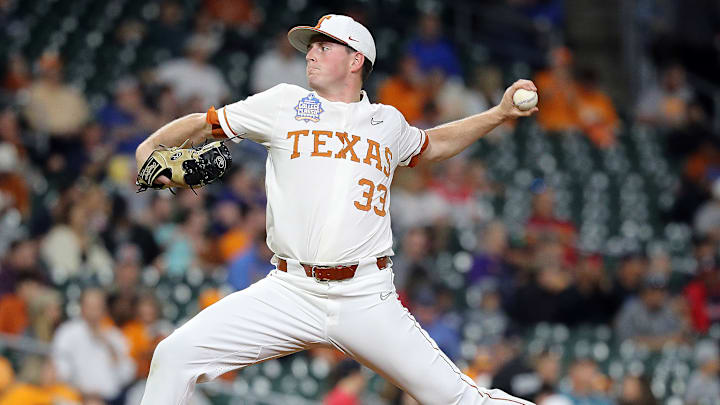26. LHS Pete Hansen (2023 level: Single-A)
Hansen is a pitch-ability lefty who has excellent control of the strike zone and a solid slider but lacks velo on his fastball. Hansen possesses a fluid, repeatable delivery that is very aesthetically pleasing to watch. It's easy to see why he can control his pitches effectively. The Cardinals drafted Hansen in the 3rd round of the 2022 draft, and he was the third college left-hand hurler the Cardinals drafted in a row, following Cooper Hjerpe and Brycen Mautz. Hansen arguably had the most prestigious college career out of that group. Across 3 seasons and 215.2 innings at the University of Texas, Hansen had a 2.67 ERA while walking less than 2 hitters per 9 innings.
Hansen has a 4-pitch mix headlined by the aforementioned slider, a four-seamer, a changeup, and a curveball. His highest-used pitch is a cut-ride four-seamer that lives around 90 mph. Due to getting around 7 feet of extension on the mound, the pitch appears approximately 1 mph faster. The offering gets around 16 inches of induced vertical break and 3 inches of arm-side from a vertical release point just under 6 feet. While the movement profile of the pitch is decent, with the pitch only being 89-91 mph, Hansen has such little room for error. If the pitch was in the 92-94 mph range, I could see it as an average offering, but I wonder if he can consistently get to that. Last season, his peak velocity was only 92.6 mph.
Straight filth from Pete Hansen as the @Cardinals' No. 14 prospect carries a no-no into the 7th for @GoPBCardinals:
— Minor League Baseball (@MiLB) May 12, 2023
7 IP
2 H
0 R
2 BB
9 K pic.twitter.com/AacJqrtJ7x
Hansen makes up for his lackluster fastball with the rest of his arsenal. Firstly, his slider is one of the best in the Cardinals' system. The pitch averages 80 mph with -0.8" IVB and 10" of sweep with a spin rate over 2600 rpm. He had a ridiculous 36% CSW% rate when using it last year. Due to having a fastball with minimal arm-side run, Hansen can tunnel his slider effectively off of it. Hansen is comfortable throwing the pitch to righties and lefties but uses it more frequently against lefties.
Hansen's third pitch is his changeup. Much like his slider, he gets a really effective tunnel on the pitch, making it hard for hitters to pick up. The pitch sits around 86 mph with around 9" of IVB and 11 inches of horizontal break. He shows an advanced feel for the pitch, and it grades out close to average. Hansen throws his changeup to righties at an even higher rate than his slider. The pitch had around a 33% whiff rate last year.
Lastly, Hansen throws a curveball in the mid-70s with a similar amount of sweep to his slider with significantly more downward break (-7" of IVB). The pitch netted great results in a small sample, but it is clearly his fourth pitch in his arsenal. While Hansen might not be the most exciting arm in the system, he's a relatively high-probability big leaguer. I love his mechanics, and although his fastball velocity could be better, he already has a solid feel for 3 secondary pitches and an overall very complementary arsenal.
